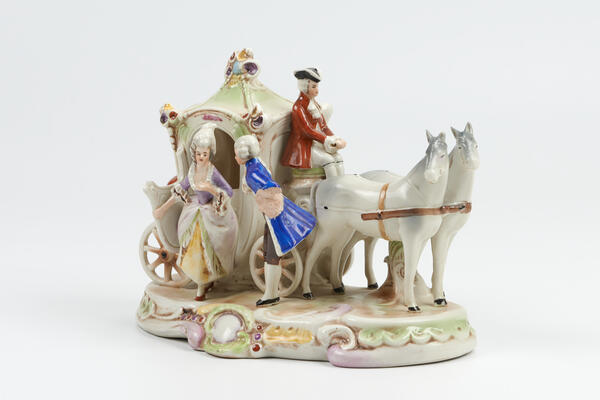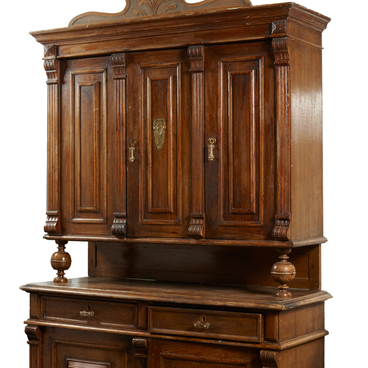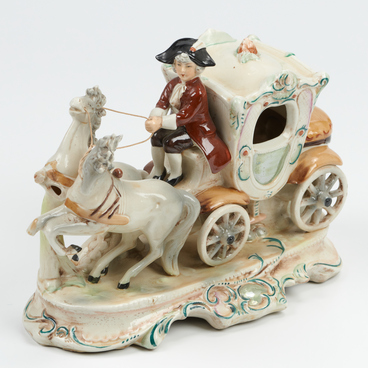Since the start of porcelain production in Europe, one could buy, besides tableware and dolls, complex sculptural compositions. The most popular out of them were ‘the fête galante scenes’. These sculptural compositions depicted ladies and noblemen, who were recreating familiar scenes from the life of the main customer and lover of porcelain ‘toys’ — the courtiers and the spoiled aristocracy. The main principle of making this sculptural composition consisted in the creation of a happy and always perfect and beautiful couple or a group of people. In addition to the fête galante sculptures, there were figurines of musicians, ordinary townspeople, and peasants.
The Museum received the sculptural composition from a collector Vladimir Shtrikker in 2002. The piece consists of a carriage drawn by two horses, a coachman, a lady who is getting out of the carriage, and a gentleman with a bouquet. The porcelain is painted in bright colors. A decorative stand with a floral relief ornament is a part of the composition.
The sculptural composition ‘Carriage’ was made by the artisans of the Carl Scheidig Porcelain Factory (Porzellanfabrik Carl Scheidig K.G.) in Gräfenthal, Thuringia. In 1925, the businessman bought the factory, founded in 1859. At the first, tableware was produced there, including children toy tableware, mostly blue and gilded in some places. However, the main specialization of the Carl Scheidig’s Factory was porcelain figurines and china sets. In 1930, the Gräfenthal factory products were available through art sales catalogues even overseas.
The Gräfenthall factory was nearly destroyed during the Second World War. After the division of Germany, Thuringia was ceded to the German Democratic Republic, and the Factory had to adjust to a new life. For some time, the enterprise remained private under the board of directors’ management and strict state control. Export of products was allowed only to the socialist countries. In 1971, for the purposes of currency inflow increases into the country, it was decided to begin export to the West, but prior the state came into possession of the production facilities.
The Museum received the sculptural composition from a collector Vladimir Shtrikker in 2002. The piece consists of a carriage drawn by two horses, a coachman, a lady who is getting out of the carriage, and a gentleman with a bouquet. The porcelain is painted in bright colors. A decorative stand with a floral relief ornament is a part of the composition.
The sculptural composition ‘Carriage’ was made by the artisans of the Carl Scheidig Porcelain Factory (Porzellanfabrik Carl Scheidig K.G.) in Gräfenthal, Thuringia. In 1925, the businessman bought the factory, founded in 1859. At the first, tableware was produced there, including children toy tableware, mostly blue and gilded in some places. However, the main specialization of the Carl Scheidig’s Factory was porcelain figurines and china sets. In 1930, the Gräfenthal factory products were available through art sales catalogues even overseas.
The Gräfenthall factory was nearly destroyed during the Second World War. After the division of Germany, Thuringia was ceded to the German Democratic Republic, and the Factory had to adjust to a new life. For some time, the enterprise remained private under the board of directors’ management and strict state control. Export of products was allowed only to the socialist countries. In 1971, for the purposes of currency inflow increases into the country, it was decided to begin export to the West, but prior the state came into possession of the production facilities.



